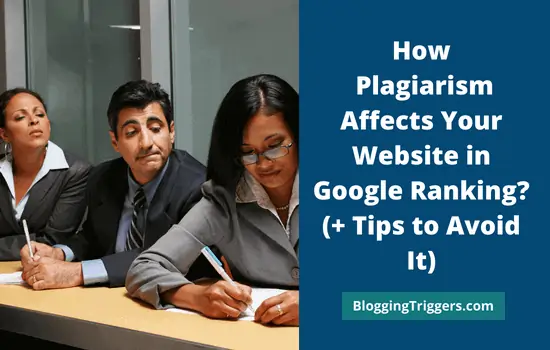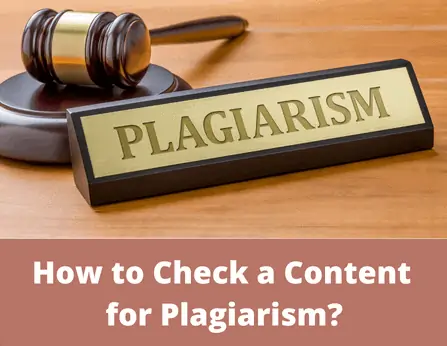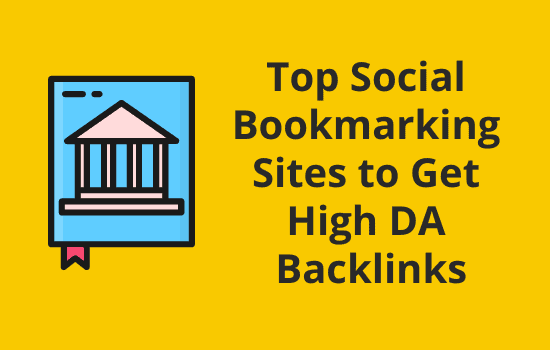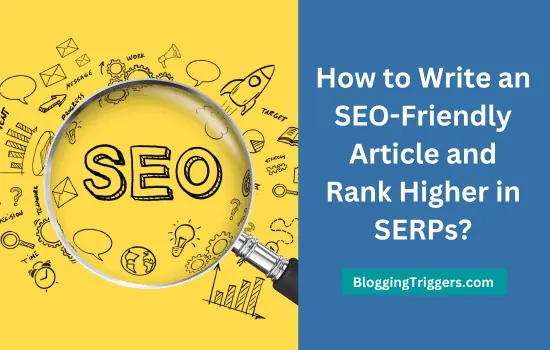
Plagiarism is the act of copying or paraphrasing another author’s work or parts thereof and passing them off as one’s own work. People can commit plagiarism, either intentionally or unintentionally, through simple mistakes. However, it has the same consequences whether someone commits plagiarism deliberately or unintentionally.
Nowadays, plagiarism is a problem in academics and other writing industries. Fortunately, there are ways to avoid plagiarism while creating new content for a website or blog. So, let’s discuss a comprehensive guide on how plagiarism affects your website in Google ranking and tips to avoid it.
Table of Contents
How Plagiarism Affects Your Website in Google Ranking?
Although there are several ways how plagiarism affects a website’s SERPs ranking, the following are the most common ones:
1. Spams and blacklists a website:
Google and other search engines prefer unique and original content. So, when the Google content checker finds plagiarism in a piece of text, it considers that piece of text spam. As a result, Google penalizes that web page and decreases its ranking in SERPs (Search Engine Result Pages). It’s the same as getting copyright strikes from YouTube officials on a YouTube channel.
However, no one knows the exact acceptable percentage of content plagiarism for Google and other search engines. But most experts recommend keeping the content plagiarism in single figures (0-9).
Thus, if a writer aims for 0% plagiarism, he can produce 80-90% plagiarism-free content.
2. Ruins the readers’ experience:
Readers look for solutions to their problems on the internet. So, when a reader goes through multiple web pages, he wants at least one new solution on every page. But if he finds the same answer on all the web pages, it will destroy the integrity and reliability of the writers of those pages. And, most probably, the reader will never return to that page again.
Thus, readers won’t appreciate duplicate content, which will hurt the traffic of a website or blog containing duplicate content.
If a user detects similarities between two web pages, the brand reputation of those web pages will never be the same in that user’s eyes.
Thus, content plagiarism also ruins the brand value of a website.
How to Check a Content for Plagiarism?

In these times, technology has made everything easier, and detecting plagiarism is no exception. Therefore, when writers want to check the uniqueness of their written content, they prefer using plagiarism checker tools.
The plagiarism checker tools use Artificial Intelligence and Deep Searching algorithms to check uploaded content for originality. Such tools scan the uploaded content in their repositories and compare them against published materials. This way, they can instantly find out whether a piece of content is unique or not.
But most newbie writers fall for the trap of free plagiarism checkers, which causes accidental plagiarism. Therefore, expert writers recommend using paid plagiarism checkers. Some popular paid plagiarism checking tools are:
- Grammarly.
- Turnitin.
- Semrush plagiarism checker.
- Copyscape.
Some Tips to Avoid Plagiarism for the SEO Game of a Website:

So far, this guide has covered how plagiarism affects your website in Google ranking and how to check the plagiarism. Now, let’s move to the tips to avoid plagiarism.
1. Prefer unique or original content:
Content uniqueness is directly proportional to the better results of a new website. So, suppose a candidate is working on the content of a new website. In that case, original and unique content should be his priority.
For example, if a content writer writes content for a saturated niche, he should identify the missing points in the published content of authoritative websites. This way, if he can locate and add those (absent) points to his content, he will have better quality and unique content than his counterparts.
2. Do not overlook LSI keywords:
LSI keywords are the related variants of a topic’s main keyword. So, suppose the main keyword of a subject is ‘coaching.’ In that case, the writer should use the suitable LSI keywords for ‘coaching,’ like ‘classes’ and ‘institutes’ while writing content. This way, he can prevent unintentional plagiarism that might occur through the frequent use of the main keyword (‘coaching’).
3. Avoid the use of article spinning:
Most newbie content writers use article spinning tools that take published content and wrongly paraphrase it using relevant synonyms. So, whether a writer writes content for a new or old website, article spinning is another killer for the SEO and ranking of a website or blog.
However, this doesn’t mean that SEO experts prohibit the use of paraphrasing in SEO content writing, which brings us to the next tip to avoid content plagiarism.
4. Paraphrasing:
As mentioned earlier, paraphrasing is one of the most effective ways to avoid plagiarism in any writing industry. But a writer should cite the source of information after paraphrasing the content because paraphrasing doesn’t make a person its original writer.
However, wrongly paraphrasing a piece of content will fall under the umbrella of plagiarism. Therefore, writers should use the following techniques while paraphrasing content.
- Do not paraphrase an entire document at once. Instead, the writers paraphrase each paragraph individually.
- Use a different initial point for a paragraph.
- Change the voice of sentences.
5. Double quotations:
Sometimes, rephrasing a piece of content changes its actual meaning, which ruins the entire essence of paraphrasing. Therefore, if it is a necessary piece of information, writers should enclose that information in double quotes and cite its reference.
This technique is another famous and go-to method of most writers to avoid plagiarism in any writing industry.
6. Technological assistance:
No doubt, the above-discussed tips help in plagiarism prevention. But suppose you want to automate the task of plagiarism removal. In that case, you can use the help of online AI-based plagiarism remover tools.
Such tools work on the basis of NLP (Natural Language Processing) and Deep Learning technology to produce plagiarism-free content according to the context of the topic.
Bottom Line – the Conclusion:
Plagiarism is a serious issue that can harm a website if not handled properly. It is illegal because it can lead to penalties, such as demotions in Google rankings and possible loss of revenue through lost traffic and sales. So, plagiarism is a big no-no for the SEO of a website. However, suppose a reader accidentally runs into plagiarism. In that case, he can apply the techniques discussed in this post to avoid duplicate content. This way, he can not only avoid the penalties of Google, but also take the upper hand over its competitors by providing better and more authentic content.



